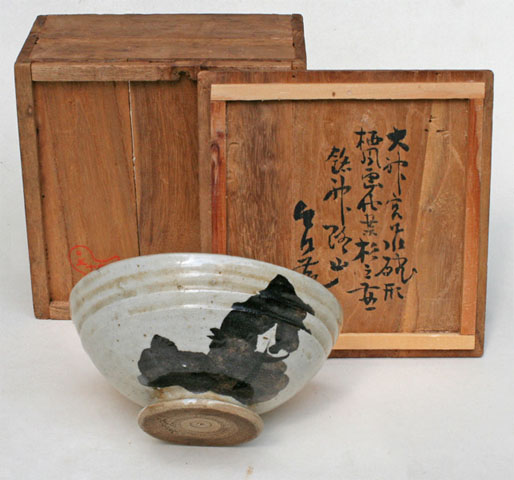Isuzuyaki
Chawan, tea bowl - KamijiyamaSigned:
Seals: [Sei]hô, Isuzu [gawa] yaki
Technique: Grey wheel turned Isuzuyaki with a black tetsu-e, iron oxide under slib and underglaze and painting of Ize cryptomeria Ø 12.4 x 5.5
Box: signed by Konnichi'an
Condition: kintsugi gold restoration at the rim, otherwise good
“Kamijiyama”, the name of the chawan, are the hills along the way to Ise
Box inscription: Izusuzu chawan, Ôkami miya onmizu chakata, Seihô gahakkei sugi nozu, Mei Kamijiyama
In the shape of a large bowl for pouring out water at the Ise shrine, The great artist Seihô made the picture of the cryptomeria (cedar trees), named: Kamijiyama.
Seihô was one of the last very important and famous Maruyama-Shijô style painters.
He was an extremely skilful painter, which earned him fame and a lot of pupils. He entered Bairei's studio at the age of 16 and already in the following year he won his first prize at an exhibition, which is a rare for such a young artist.
He eagerly studied all different styles. In 1900 he went to Europe for six months to get acquainted with western painting. On his return he changed the first character "Sei" of his name into a character meaning "West". His two trips to China in 1920 and 1921 meant another enrichment to his painting. His flexibility in styles and the flamboyantly virtuoso way he handled his brush meant in the eyes of some critics that his craftsmanship reduced his artistic abilities.
Reference:
Next to a number of monographs and in any general book on modern Japanese painting:
Harada 1981
Berry & Morioka ‘99 pp. 130-137
Conant pp. 322-323
Roberts p. 171
Araki p. 1633
The Isuzu kiln is on the borders of Isuzu gawa in Ize. It was founded in 1910.
Price: ON REQUEST

